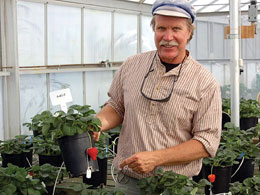Volume 28 · Number 4 · Summer 2011
Best of breed

Cooperative Extension specialist Kirk Larson leads the strawberry breeding program and the South Coast Research and Extension Center in Irvine. (Diane Nelson/UC Davis)
To see plant breeding in action, watch strawberries grow at the 200-acre UC South Coast Research and Extension Center in Irvine, where the winters are mild, the summers are warm and the coastal breezes are lovely.
"Isn't that nice?" asked Cooperative Extension Specialist Kirk Larson, smiling as a salty wind stirred the warm Irvine air. "I love that afternoon breeze. So do strawberries, which is why they do so well in this climate."
Larson leads the strawberry breeding program at the center, working closely with plant breeder and UC Davis Professor Doug Shaw. Shaw uses genetics to help determine which strawberries might make good parents.
"We're looking for traits that improve life for strawberry growers and consumers, developing varieties that are sweet, juicy, conical, colorful and sturdy," Larson explained. "We also look at yield and timing of that yield. If you're a grower, you don't want all your berries to come ripe when the market is glutted."
Once Shaw and his team identify plants with potentially good genes, Larson and his team manage the horticultural aspects — spacing, disease control, fertilizer and such — helping them grow to their full genetic potential.
UC holds 33 patents on strawberry cultivars that generate almost $5 million in royalties each year. Varieties developed by the UC strawberry breeding program produce about 60 percent of the strawberries consumed worldwide.
To create a winning variety, breeders cross plants with desired traits and select the best offspring over multiple generations. It's like time-lapse evolution, although it really doesn't happen very quickly. It takes about seven years of plot testing to give birth to a strawberry variety good enough to name.
"Here's a plot of berries we're evaluating," Larson said, standing amid a sea of green and red. "I walk down each aisle with a clipboard and rank each berry on a scale of 1 to 5 for taste, color, shape and firmness. I do it once a week for 26 weeks, and I do it blindly. I don't want to be influenced by who its parents are, or how I ranked it the week before."
He moved down the row, picking and tasting as he goes. Some berries are too watery. Some are too bland.
"Here's a beauty," he said. "Nice shine. Nice shape." He bit into it. "Holy cow! What an interesting flavor! It tastes sort of like a mango."
After weeks of testing, Larson will put flags beside the plants with consistently high marks. They will become his future. He will propagate them and begin testing all over again.
"We just keep narrowing it down until we find a variety that has it all."
Thanks to years of this plant breeding science (with a big assist from California's climate), strawberry farmers in this state have a 12-month growing season compared with a few months or weeks in other regions. California strawberry growers provide more than 87 percent of the strawberries consumed in North America.
Back to "Nurturing a rare breed"
